There is little arguing that CD-R disc label printing has come a long way in terms of price and capability in a few years and the future promises more exciting developments.
CD-R, Fit to Print: Printing Devices for CD-Recordable
Hugh Bennett
EMedia Professional, August 1997
The commercial audio CDs and CD-ROMs that line retail store shelves have their handsome labels applied at the factory using spot or four process color silkscreening or pad printing methods. The results vary, but when designed by careful artists who know what they are doing, the results can be magnificent. However, with the expense of the equipment and set-up time required, silkscreening and pad printing are invariably limited to the manufacturing process of the replicator who specializes in large runs of identical discs.
When CD-Recordable stepped forth to make small runs and single copies of discs a viable option, the new era in disc-making CD-R initiated demanded a whole new disc printing process, proving necessity the mother of invention yet again. The origins of inkjet CD-R label printing can be traced back to that very historical juncture in 1988 and the early days of the Start Labs recording service joint venture of Sony Electronics and Taiyo Yuden. According to Taiyo Yuden’s Tad Ishiguro, “at that time we had to put a small UV label printer in the Tokyo office because we found that our customers required not only their original contents on disc, but they also wanted a label.”
As a result of this early experience, Ishiguro says, “In 1991 I proposed the idea of CD-R printable to Taiyo Yuden’s engineers with two main requirements: that the label can be printed by inkjet printers already in the market (with some modification), and that the label be manufactured by a regular CD-R production line, meaning the printable layer should be formed by a UV label printer.” According to Ishiguro, the Taiyo Yuden engineers came up with a suitable material a year later called UV-curable Ink Absorption Layer (IAL), and it was at intermedia 1993 that Taiyo Yuden announced the development of CD-R Printable.
Also emerging in recent years is CD-R printing that uses thermal transfer technology traditionally used in barcode label printing. The first — and currently only — exponent of this approach is Rimage’s Perfect Image CD Printer, which delivers high-quality disc printing and has made particularly impressive inroads as a component of high-end CD-R duplication systems.
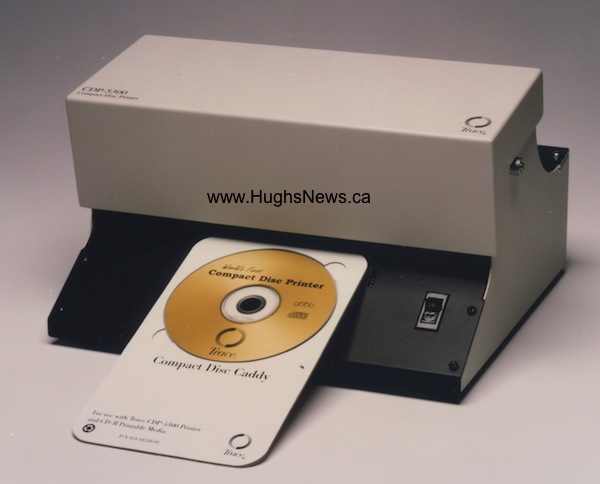 CD-R, Inked: The Inkjet World
CD-R, Inked: The Inkjet World
In conjunction with the introduction of printable media, Trace Mountain released its CDP-5300 Compact Disc Printer, which became the first inkjet compatible with Taiyo Yuden’s new product. By today’s standards the CDP-5300 was expensive ($4600) and crude (360 dots-per-inch, or “dpi,” b/w), but it filled a real need and offered a design model which many current inkjets still follow. And the reasons for Taiyo Yuden’s initial pursuit of inkjet printing for CD-R and the continued technological union are as clear as the appeal of inkjet printing in everyday paper printing applications. Namely, inkjet is cheap and produces solid results.
The use of inkjet for CD-R printers makes a great deal of economic sense since they leverage mass produced systems by adapting existing commercially available printers. Among several printing engines currently in use are those from Epson, Canon, and Lexmark. And while these manufacturers and others could develop higher quality printing mechanisms, it would take more than simply upgrading existing off-the-shelf printers. A real quantifiable quality leap would require designing new printers and special inks from the ground up, at a prohibitive cost given the relatively small size of the market. But millions of standard inkjet printers and ink cartridges are sold every year, resulting in a huge advantage and economies of scale.
And as the sales volumes and range of available products grow, so does the quality of inkjet printers continue to improve, and CD-R printers reap the benefits of research and development work done by others. While early inkjet technology offered only black and white quality not very different from impact dot matrix, today’s leading inkjet models promise three, four, and six-color 720dpi and even 1,440dpi quality.
And even applied to the new and seemingly quite different frontier of CD-R, the basic concept behind inkjet printing–the printer ejects liquid ink onto the page by a variety of methods–remains roughly the same. Epson printers use a proprietary piezoelectric print head that precisely forces tiny ink droplets out of many print head nozzles using mechanical pressure. Systems manufactured by Canon, Lexmark, and others use heat to eject the ink from the head and are therefore sometimes called thermal inkjets.
A New Kind Of Paper Magic
Like rain on a waxed car, the inks used by everyday inkjet printers are not absorbed or do not adhere to the smooth, hard lacquered surface of CD-R discs. As a result, a special hydrophilic coating, commonly known as an Ink Absorption Layer (IAL), must be supplied so the ink can stay in one place long enough to dissipate the solvents and properly dry. Most manufacturers offer discs that are specially made in this manner for inkjet printing.
What is required of IAL layers in CD-R printing is fairly well understood since much of the science and intellectual property associated with the special coatings needed for conventional inkjet paper are applicable to printable CD surfaces. The simplest way to think about the challenges of developing an IAL for CD-R is to see the media company as basically providing the printer with a new type of paper.
But something that seems as simple as providing a suitable receptive layer onto CD-R media itself is actually a complex balancing act and its difficulty should not be underestimated. The magic of the IAL involves having a material that will receive ink and provide a combination of absorption and air drying so the ink does not just form a capsule on the surface that would not dry completely. Further complicating matters is the need today, for IALs to accommodate the wide variety of printer engines, each one using different inks with different solvents. Unlike most inkjet paper, which is specifically optimized to deliver the best possible results with a specific printer at different resolutions, printable CD-R discs try to take into consideration all forms of inkjets and addressable resolutions. If they did not, each manufacturer would end up offering a dozen different discs.
Add to these challenges the problem of balancing image quality and durability. The inks used by inkjet printers are primarily water-based and are, consequently, susceptible to smearing by a wet finger in what some call a “lick test,” or may be washed away by a volume of water. The danger of increasing durability at the expense of image quality makes this area of printer design a delicate balancing act, and the product that results ultimately reflects the manufacturers’ understanding of which feature–durability or image quality–their customers prize more.
And these basic complications are compounded by the fact that some materials associated with inkjet printing will not work in a CD production process environment. As Taiyo Yuden’s Ishiguro explains the challenge, “Traditional IALs coated on paper or transparencies are dried and cured by heat to form the ink absorption layer. As a result, this kind of conventional IAL is not good for the label material for CD-R, because the thermal curing process is not suitable for the in-line CD-R production.”
The Color Of Printable Surfaces
In the beginning, Taiyo Yuden was the only media manufacturer that produced printable CD-R discs. As the market for printable media has grown, however, so have the number of manufacturers pursuing the printable market. Printable CD-R media are now available from all the major players in the CD-R media field, including Eastman Kodak Company, Mitsubishi Chemical Company, Mitsui Toatsu Chemicals, TDK Electronics, Ricoh Corporation, and Pioneer Video Corporation.
And with this printable critical mass has come expectation of color and heightened image quality. Gold-surface discs, available from all the manufacturers, are fine for a lot of work, but the gold background introduces color shifts and does not provide the type of high contrast needed for barcode applications. Various companies have introduced ways of improving image quality. For example Mitsubishi Chemical, the parent company of Verbatim Corporation, introduced the DataLife Plus disc, which uses a silver-alloy reflective layer which has the effect of giving the discs a light gray appearance that avoids gold color shift effects.
Another solution is to offer a printable disc with a white surface. Such discs are currently available from TDK, Taiyo Yuden, and Mitsui Toatsu. None of the manufacturers of printable white discs will openly discuss how exactly they achieve the white color, but it seems apparent that white discs could be produced in a number of ways, such as laying down a white silkscreen and covering it with a transparent IAL, or actually tinting the IAL the desired color. Of course, to customers, image quality and color perception are highly subjective matters, and as a result, manufacturers face the unenviable task of trying to find out what the customers want, and then identifying the desired degree of a disc’s “whiteness” by wrestling with the wonderfully Socratic question of “what is the essence of white.”
As the printable CD market continues to evolve, manufacturers continue to modify and tweak their IALs, so it should come as no surprise that the disc you buy today may have different characteristics from the disc you bought a few months ago. The best advice for the image-conscious is to buy a sampling of discs from a variety of manufacturers and compare the results to see which you like the best.
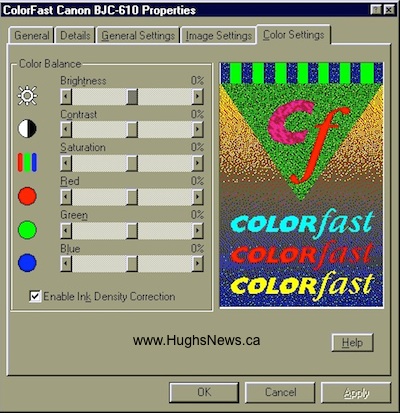 Software And Drivers: Application And Moderation
Software And Drivers: Application And Moderation
Perhaps the most critical parameter of inkjet printing is applying the correct amount of ink to the disc. Risks of laying on too much ink will always loom, given that by its nature the printing process builds ink volumes when colors are combined or when the resolution is increased. Since the ink must go somewhere (down, up, or out), too much applied ink will bleed, dry slowly, or not dry fully.
Successful printing therefore depends on the combination of the source program, interpreter, and media used. The source program used in disc printing could be something as straightforward as a word processor, or something more involved such as a page layout or sophisticated graphics application. Programs like Corel Draw or Adobe Illustrator provide control over gaps so as to be able to leave space between graphics with adjoining colors so they do not bleed or spread into each other.
The interpreter, also known as the driver, directly controls the printer and translates between the source program and the hardware. Normally you are stuck with the driver that the manufacturer includes with the printer; in addition to affecting printing speed, a good driver can be used to optimize printing conditions. One problem all CD-R inkjet printers share is that in addition to using off-the-shelf printing engines and inks designed for other purposes, they also must use off-the-shelf drivers which are not necessarily optimized for the characteristics of printable CD-R surfaces. Good printer drivers, then, are those that provide users who want to get the best image possible with precise control over ink density, which allows individual control over such parameters as brightness, contrast, and saturation and red, green, blue, and black intensity.
Media manufacturers also devote considerable effort to providing a wide range of capabilities, and have been reasonably successful in making their media as flexible as possible in the variety of printing methods for which the discs are suited. But adaptable media does not eliminate frequent need to play with printer settings to achieve the desired result. For example, since clip art and logos normally incorporate large solid areas of color, they require applying higher volumes of ink to a given disc. As a result, providing a small gap between multiple adjacent colors and reducing the intensity of the colors provides a more satisfactory result.
The Inkjet Set: Currently Available Inkjet Printers For CD-R
Currently available inkjet CD-R printers come in a range of configurations, offer assorted and varied capabilities, carry a disparate range of price tags, and are available from a number of manufacturers. The current roster includes long-time producers Craig Associates International (CAI), Data/Ware Development, and Imedia Technologies. Newcomers dotting today’s market include Fargo Electronics, Affex, and SuperImage. Additional offerings from startups are also appearing at regular intervals.
The present crop of printers are based on familiar Canon, Epson, and Lexmark engines, and reflect the existing range of available printing quality. Resolutions range from 600 X 300dpi to 720 X 720dpi in three or four color systems.
The two most common ways of loading discs into the printers are using a caddy carrier or motorized tray. Since caddy carriers minimize the modifications necessary to convert off-the-shelf inkjets into dealing with CD-R discs, these systems are by far the most popular. The caddy consists of a flat piece of plastic with a circular depression for holding the disc in a fixed position while the printing process occurs; the caddy containing the disc is then inserted into the printer like a piece of paper and the mechanism draws it through. Because the printer’s paper path remains intact, some caddy-based printers, such as Affex’s HardCopy and SuperImage’s MediaPrinter, also allow the printing of ridged media in addition to CD-R discs.
The obvious downside to the caddy system is that it is not suited for unattended or high-volume work. A mechanized tray system, on the other hand, operates just like a CD-ROM drive tray and lends itself more to unattended or automated CD duplication and production devices.
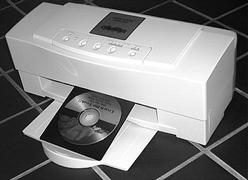 Craig Associates International: Four-Color First-in-Field
Craig Associates International: Four-Color First-in-Field
The most established and easily recognizable of all the CD-R inkjet printer manufacturers is Craig Associates International. The company has operated at the nexus of CD-R and inkjet technology since the company became the first to introduce color printing to the CD-R world in 1994 with its Colorscribe 6000.
Time has been good to CAI, and the company has responded well to changing times and expectations, pushing the Colorscribe 6000 through a constant evolutionary process. Today’s Colorscribe 6000 is a reasonably fast, 720 X 720dpi four-color printing system based on a converted Canon BJC-620 inkjet engine. According to CAI president Herb Craig, the company will soon introduce the next product in the Colorscribe line, the Colorscribe 9000. This new printer uses the same BJC-620 engine as the Colorscribe 6000, but employs a tray disc-loading system and offers a more rugged design for heavy use in standalone and automated inline printing applications. Craig expects the price to settle “somewhere in the $4,000 range.”
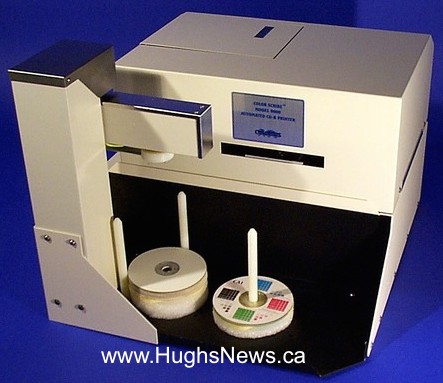 The current $1,995 Colorscribe 6000 package is thoughtfully complete and in addition to the printer, bundles a full set of ink cartridges, a parallel printer cable, two ridged-disc caddies, ten cardboard templates for test printing, LaserTools Colorfast printing drivers, and a version of Corel Draw 3.0 that includes pre-made templates for making your own labels. A Macintosh version is also available and comes with a serial-to-parallel interface converter and templates for MacDraw, Canvas, and QuarkXPress.
The current $1,995 Colorscribe 6000 package is thoughtfully complete and in addition to the printer, bundles a full set of ink cartridges, a parallel printer cable, two ridged-disc caddies, ten cardboard templates for test printing, LaserTools Colorfast printing drivers, and a version of Corel Draw 3.0 that includes pre-made templates for making your own labels. A Macintosh version is also available and comes with a serial-to-parallel interface converter and templates for MacDraw, Canvas, and QuarkXPress.
The high-end Colorscribe closely resembles its consumer-oriented counterpart and maintains its relatively compact 16.1″W X 9.7″D X 7.2″H and 10-pound dimensions. A true four-color printer, it uses separate cyan, magenta, yellow, and black (CMYK) standard Canon ink cartridges. Craig provides one-year warranties on all Colorscribe models and offers next-day replacement of broken units–an excellent service for production-intensive environments.
For those seeking the best image quality, one attractive feature of Colorscribe printers is the LaserTools drivers software, which offers precise control over image quality and ink, precise and individual control over brightness, contrast, saturation, red, green, and blue.
Imedia Technologies: Canon-Based High-Quality Control
Originally available only in Europe, the CD Color Printer from French manufacturer Imedia Technologies is now available in the United States from MediaFORM, which distributes the printer as the MediaFORM CD-CP1.
The CD-CP1 uses a Canon BCJ-620 engine and is essentially a clone of the CAI Colorscribe 6000, but instead of maintaining the consumer appearance, the CD-CP1 is housed in a metal enclosure. In addition to the printer, the basic package includes two ridged plastic disc caddies, five cardboard templates for test printing, a parallel interface cable, Canon BJC-620 printer drivers, and pre-drawn Corel Draw templates.
The CD-CP1 promises the same high-quality printing capability as the CAI Colorscribe and the included Canon drivers offer similarly precise color controls.
Affex Corporation: The Epson Engine Hard-Copied
One of the several new CD printer companies that introduced products at the fall 1996 Comdex exhibition was Affex Corporation. With the release of the $1,295 HardCopy printer, Affex became the first company to adapt Epson’s well regarded StylusColor 500 inkjet engine for CD printing.
The HardCopy largely maintains the trademark look common to most Epson printers, such as the compact footprint of 10″W X 9.8″D X 7.8″H X and 11.3-pound girth. Like its Canon-based competition, the HardCopy offers 720 X 720dpi capability and is a true-four color printer, but unlike the Canon uses only two cartridges– one a black ink repository and the other tri-color–instead of separate containers for each color of ink. Since the HardCopy largely maintains its original Epson paper path, it is able to pull double duty by being able to print to paper and rigid media such as cardboard in addition to CD-R.
The HardCopy does not play favorites and offers both Macintosh serial and PC parallel connections as well as driver software. In addition to the printer, the HardCopy includes drivers for Macintosh and Windows 3.1 and 95, plus two double CD carriers and pre-made templates for popular Mac and PC graphics programs. The included set of Epson drivers provide a good range of settings for most users as well as sophisticated control over color balance. Macintosh users will also benefit from the included ColorSync color correction software, which helps the user obtain output from the printer more closely matched to what is seen on-screen.
SuperImage: Sub-$1000 Media Printing
Another newcomer to the world of CD-R disc printing is SuperImage. Much like the Affex HardCopy, the $999 MediaPrinter 500 is one of the more economical printing alternatives and is based on the same four-color Epson StylusColor 500 inkjet engine.
The SuperImage MediaPrinter is sold in several configurations and bundles. Typical packages include PC and Macintosh drivers, software templates for popular graphics programs, and two ridged caddies for printing up to two discs at a time.
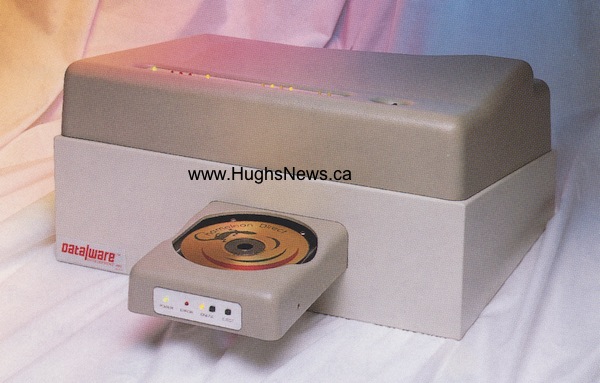 Data/Ware Development: Rugged and Production-Ready
Data/Ware Development: Rugged and Production-Ready
A company that has taken a slightly different approach in developing a CD-R printing system is vertical market integrator Data/Ware Development, now a division of information systems and services giant Anacomp, Inc. The fact that Data/Ware’s ChameleonDirect printer is intended for high-production environments is reflected in the product’s tank-like design. Like CAI’s and IMT’s printers, the ChameleonDirect is based on a Canon BCJ-620 inkjet engine, but it is made more rugged for production use and offers tray disc-loading instead of caddies.
Data/Ware markets the printer in several packages. The ChameleonDirect and ChameleonDesktop bundle the printer with accessories for use by itself. Also available is the ChameleonTransporter, which pairs the printer with a Kodak 75-disc autoloading Disc Transporter; the printer can also be purchased in a rackmount configuration for use with Data/Ware’s turnkey CD production systems, the Enterprise Authoring System (EAS) and the Server/ Enterprise Authoring System (S/EAS). The EAS and S/EAS provide automated output to CD-R in mainframe and client/server environments with applications such as check imaging, billing statement distribution, and high-volume report and documentation distribution.
 Thermal Transfer Printing
Thermal Transfer Printing
The other major printing technology adapted for CD-R printing use is thermal transfer, which has humble roots in traditional barcode label printing. Rimage pioneered a solution in 1995 that adapts that existing thermal transfer technology to CD-R, and to date the company’s Perfect Image CD Printer remains the only thermal transfer printer on the market.
Unlike inkjet technology, which sprays liquid ink, thermal transfer conveys solid polymer from a coated ribbon onto a disc’s surface. To label a disc, the printer presses a stationary print head containing very small heating elements against the traveling ribbon to contact the surface of the disc. Through the combination of significant heat and pressure, the ink is transferred from the ribbon substrate to the disc as a sliding tray moves the disc past the print head. And unlike inkjet printing, thermal transfer does not require specially coated CD-R discs to accept the ink from the printing process. The printers thus work well with lacquer, durability-coated, and silkscreened discs.
However, that functional flexibility does not mean that some disc surface choices don’t mesh with thermal transfer more effectively than others. Though the flat, shinny surface of a lacquer disc provides the most crisp and consistent results, it is advisable to use media with abrasion-resistant surfaces, such as those offered by Mitsui Toatsu, Eastman Kodak, and several others, to provide the best balance between image quality and data safety. This practice ensures additional protection not only during the printing process, but also from regular handling. Mitsubishi/ Verbatim’s coating on the latest DataLife Plus discs is also designed to meet this specification.
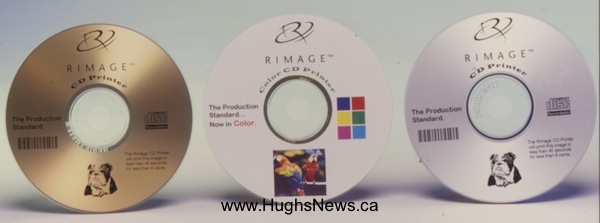 The Perfect Image CD Printer has caught the attention of media manufacturers since it has proven particularly popular in high-end CD duplication systems and thus in applications which consume great quantities of discs. As a result, a number of companies have released discs specifically designed for thermal transfer printing. Taking the lead from white inkjet media, these new thermal transfer-optimized discs also display white surfaces. The white background provides excellent print contrast for barcode applications, improves disc durability, and is quite pleasing to the eye. Discs designed in this vein are currently offered by Kodak, Mitsui Toatsu, TDK, and Imation.
The Perfect Image CD Printer has caught the attention of media manufacturers since it has proven particularly popular in high-end CD duplication systems and thus in applications which consume great quantities of discs. As a result, a number of companies have released discs specifically designed for thermal transfer printing. Taking the lead from white inkjet media, these new thermal transfer-optimized discs also display white surfaces. The white background provides excellent print contrast for barcode applications, improves disc durability, and is quite pleasing to the eye. Discs designed in this vein are currently offered by Kodak, Mitsui Toatsu, TDK, and Imation.
The Perfect Image CD Printer indeed has much to recommend it as an alternative to inkjet, and what it lacks in multicolor printing it makes up for in impressive image durability. Unlike the water-based inks used in inkjet printers that can smudge or bleed, the ink used in the thermal transfer is more permanent making it a good choice for long-term or well-handled discs. Only a conscious effort with a fingernail or hard instrument can scratch it away.
What’s next In line For CD Printing?
There is little arguing that CD-R disc printing has come a long way in terms of price and capability in a few years and the future promises more exciting developments. It is also clear that as the state of the art progresses in commercial inkjet technology, so will the capability of CD-R printers. Already, several companies are working with next-generation photo-realistic-quality 1440dpi printing engines from Epson and others and plan to release products in the near future. Some, such as Mitsubishi/Verbatim, are thinking of taking a less conventional approach and have publicly discussed adapting continuous-tone inkjet technology from Alps Electric, whose unique Micro Dry pigment inks (including metallics) may offer high image quality and improved durability.
Other technologies also loom on the horizon. For example, several companies are now working on taking thermal transfer technology to the next logical stage with full dye sublimation products which will offer highly durable photographic-quality color printing. Considering that DVD-R and DVD-RAM media have the same surface dimensions as CD-R, the long-term business opportunities are enormous. The possibilities are exciting because the technology will only get better and the prices will only get lower as more companies enter the fray.
 Focus on Fargo: Major Printer Player Puts Signature on CD-R
Focus on Fargo: Major Printer Player Puts Signature on CD-R
A newcomer to the compact disc market, Fargo Electronics is better known to the outside world for its line of low-cost traditional dye sublimation and thermal wax transfer printers. Continuing its self-proclaimed quest to offer innovative products to new markets, Fargo has become the first major printer company to add a CD-R disc printer to its product mix. The first model is a color inkjet device.
The $1,296 inkjet Signature CD Color Printer weighs in at a light 8.5lbs and boasts stylishly compact 10.5″ X 7.5″ X 10.5″ dimensions. Simple controls on the top of the unit include three buttons for power, tray open/close, and ink cartridge replacement and two lights indicating power and busy status. The rear panel contains standard parallel and mini 8-pin serial interface ports for connection to a PC or Macintosh computer as well as an auxiliary port for use with disc transporter and autoloading devices.
In addition to the printer, Signature bundles include one color inkjet cartridge, five cardboard templates for test printing, power cable, documentation, driver software for Windows 3.1/95/NT and Macintosh, and a rudimentary application for designing labels. System requirements are a reasonable 486/66MHz PC or 68040 Macintosh with 8MB RAM and 100MB free hard drive space. The consumables for the Signature include a three-color ($52.95) or black ($39.95) ink cartridge as well as a ($24.95) package of 50 two-sided cardboard printing templates for test printing. A number of manufacturers are also now selling the Signature under their own private label, the most prominent being Smart and Friendly with their $999 CDRP1000 color printer.
Fargo’s Signature is an inkjet system that borrows Lexmark (former printing division of IBM) printing equipment to provide color 300 X 300dpi resolution with a maximum 600 X 300dpi output capability. The Signature uses a three-color cyan, magenta, and yellow (CMY) cartridge which can be swapped out for a black (K) cartridge for more economical monochrome printing.
Signature Installation and Ease-of-Use
Installation of the Signature is as easy and familiar as any other inkjet printer and the included driver software offers control over most basic functions. Choices in the driver settings include such options as selecting the type of media to be printed (CD or booklet), specifying the ink cartridge installed (color or black), printing quality (draft or presentation), dithering (optimized for photos or graphics), and the like. A 32-bit spooler is also included for Windows 95 and in addition to its spooling capabilities, the software displays the type of ink cartridge installed as well as its current ink levels.
One useful feature of the printer driver is that it automatically knocks out the center hole and masks the exterior of a disc so there is no chance of printing outside a disc’s printing boundary and making a mess as can happen with caddy-based printers. Another feature sure to play to rave reviews is the simplicity of disc-handling afforded by the Signature’s automatic tray-loading design.
The loading system also makes the printer a good candidate for integration into automated solutions; one bundle where the Signature has already taken center stage is Cedar Technologies’ Desktop CD-R Publisher.
Tougher Than The Rest: Fargo TuffCoat Media
One of the main aspects of the Signature printer that sets it apart from other inkjet models is the TuffCoat CD-R discs that Fargo recommends for use with the system. In order to provide the best balance of image quality and label durability, Fargo’s new media uses the company’s own ink absorption layer specially formulated for the Signature.
Be aware that Fargo is currently the only source of TuffCoat media and pricing is more expensive than traditional inkjet printable media. It is also possible to use other printable discs with the unit, but choosing another brand may mean sacrificing the added durability the TuffCoat blanks provide. Currently, none of the companies making printable media takes the Lexmark engine into consideration in tuning their disc’s receptive layer, so quality will suffer if these printables are used with the Fargo system. Several companies, however, indicate that they are now retuning their discs to adapt them more effectively to the Fargo.
During testing, labels printed by the Signature on TuffCoat discs proved very smudge- and moisture-resistant and capable of easily surviving damp finger runs across the surface. In addition, all labels were dry by the time the discs emerged from the printer.
Image quality of TuffCoat discs printed with the Signature proves consistently good, and the pairing also provides the added ability to print photos and small text. With a little fiddling, users can achieve quite attractive printing results. However, in terms of raw image quality, the 600 X 300dpi Signature with TuffCoat discs cannot compete with higher resolution, four-color 720 X 720dpi inkjet printers using some of the latest printable surface discs.
The Signature is hampered by its three-color ink system which, when using the color cartridge, produces medium-quality blacks with red bleeding around the edges. The potential image quality of the Signature would improve significantly with the addition of color matching software and a driver to permit more precise control over ink flow. A more sophisticated labeling application would also help.
In relation to its other inkjet competition, the Signature proves noisier and prints somewhat slower. For example, a full-surface color label printed at the Signature’s highest resolution takes roughly four minutes to print compared with two and a half minutes when printed by a Craig ColorScribe 6000.
But whatever shortcomings result from the Signature printer’s mid-range resolution and its coloring confines, Fargo deserves kudos for putting a lot of thought into the Signature. One especially nice feature is the printer’s ability to produce jewelcase inserts on cards Fargo includes with their TuffCoat discs. The insert printing process is quick and straightforward: users simply remove the booklet from the jewelbox, tear along a perforation, insert it into the printer, hook it under two securing clips, and print.
One company seeking to expand the market for Fargo’s Signature printer is Microboards Technology, which recently announced the PrintWrite CD-R disc. According to Microboards, the PrintWrite is a white-surface printable disc specifically optimized for use with the Signature and developed in conjunction with Taiyo Yuden. Unfortunately, no samples were available in time for testing, but Microboards indicates that the new disc provides a lower-cost alternative to Fargo’s TuffCoat media and is represented as being “smudge-resistant,” though not as much as Fargo’s TuffCoat media, with its proprietary coating.
Fargo’s Signature: Quality and Durability Hand in Hand
The best way to sum up the Signature is to say that it fits Fargo’s typical philosophy of good quality printing for low to mid-ranged markets and that it provides the best balance between color image quality and label durability in the inkjet world. The Signature also makes an excellent choice for users who do not have a lot of graphics experience but desire attractive and effective labeling results.
There is no question that Fargo’s Signature brings CD printing to a new level of affordability and ease of use, which makes the printer’s emergence a breakthrough akin to Hewlett-Packard’s entrance to the CD recorder market. Hewlett-Packard’s debut brought CD-R to a wider audience by the attraction of a brand name, lower prices, and improved simplicity. With its paper-printing positioning and know-how, and the quality-durability one-two punch the Signature provides, Fargo stands to do the same for CD-R printing. And much like the state of CD-Recordable technology when Hewlett-Packard arrived on the scene, as Fargo kicks off a new era in CD-R printing, the technologies that drive the Signature and other current printers have come a long way but still have much room to evolve.
Companies Mentioned in This Article
Affex Incorporated
185 Paularino Avenue, Suite A, Costa Mesa, CA 92626; 714/434-1242; Fax 714/434-1247; http://www.affex.com
Cedar Technologies
7400 Metro Boulevard, Suite 100, Edina, MN 55439; 612/893-2934; Fax 612/835-1867; http://www.cedar-tech.com
Craig Associates International
142 North Milpitas Boulevard, Suite 312, Milpitas, CA 95035; 408/254-0395; Fax 408/258-4935
Data/Ware Development (Division of Anacomp)
12365 Crosthwaite Circle, Poway, CA 92064; 619/679-9220; Fax 619/513-0803; http://www.dwdi.com
Eastman Kodak Company
343 State Street, Rochester, NY 14650; 800/CD KODAK; http://www.kodak.com
Fargo Electronics 7901 Flying Cloud Drive, Eden Prairie, MN 55344; 800/205-5852, 612/941-9470; Fax 612/941-7836; http://www.fargo.com
Imedia Technologies (IMT)
1 Ã 7 rue Henri de France, 95 870 Bezons, France; 33-01-34-34-3777; Fax 33-01-3434-3770
MediaFORM, Inc.
400 Eagleview Boulevard, Exton, PA 19341; 610/458-9200; Fax 610/458-9554; http://www.mediaform.com
Microboards Technology, Inc.
1480 Park Road, Suite B, P.O. Box 846, Chanhassen, MN 55317; 612/470-1848; Fax 612/470-1805; http://www.microboards.com
MTC America, Inc./Mitsui Toatsu Chemicals, Inc.
2500 Westchester Avenue, Suite 110, Purchase, NY 10577; 800/MTC-CDRS, 914/253-0777; Fax 914/253-0790; http://www.mitsuigold.com
Rimage Corporation
7725 Washington Avenue South, Minneapolis, MN 55439; 800/445-8288, 612/944-8144; Fax 612/944-7808; http://www.rimage.com
Smart and Friendly, Inc.
20520 Nordhoff Street, Chatsworth, CA 91311; 818/772-8001; Fax 818/772-2888; http://www.smartandfriendly.com
SuperImage
27121 Aliso Creek Road, Suite 130, Aliso Viejo, CA 92656-3361; 714/362-5427; Fax 713/362-5428; http://www.superimage.com
TDK Electronics Corporation
12 Harbor Park Drive, Port Washington, NY 11050; 800/835-8273; 516/625-0171; http://www.tdk.com
Verbatim Corporation
1200 W.T. Harris Boulevard, Charlotte, NC 28262; 800/759-3475, 704/547-6500; Fax 704/547-6609; http://www.verbatim.com
About the Author
Hugh Bennett, editor-in-chief of Hugh’s News, is president of Forget Me Not Information Systems, a reseller, systems integrator and industry consultant based in London, Ontario, Canada. Hugh is author of The Authoritative Blu-ray Disc (BD) FAQ and The Authoritative HD DVD FAQ, available on Hugh’s News, as well as Understanding Recordable & Rewritable DVD and Understanding CD-R & CD-RW, published by the Optical Storage Technology Association (OSTA).
Copyright © Online Inc. / Hugh Bennett